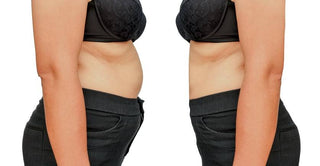When it comes to getting rid of body fat, liposuction is considered the closest thing we have to instant gratification. After all, you’re permanently removing fat cells from your body! But every procedure has limits, and the number one question for anyone considering lipo always tends to be: how much fat can safely be removed?
“The amount of liposuction that can be performed safely seems to depend in part on how much fat content a person begins with.”
A new study published in the journal Plastic and Reconstructive Surgery suggests that it’s not a one-size-lose-all approach; instead, surgeons can look at a patient’s BMI to determine how much fat can be safely extracted during liposuction.
Current guidelines specify that large volume liposuction (>5000 ml) be performed in a hospital setting as this volume carries increased risk for complications.
In the current study, researchers analyzed data from more than 4,500 liposuction patients to determine a connection between complication risk and the amount of fat removed.
Patients were primarily women, aged 41 years and considered overweight (BMI or Body Mass Index of 26.5). Virtually all of the procedures were done on an outpatient basis under general anesthesia with an average liposuction volume of 2.1 liters (about 4.2 pounds).
Trying to figure out how much fat will be removed in your liposuction procedure? Read board certified plastic surgeon Kenneth Dembny, M.D.’s great explanation on RealSelf.
The good news is that the study shows that liposuction, when performed by a board-certified plastic surgeon, is safe and associated with a very low complication rate (1.5%) and few serious complications.
Video: How Liposuction Removes Fat, Shapes Body
Patients with complications had larger liposuction volumes. The complication rate was 3.7% in large volume liposuction (>5000 ml) compared with just 1.4% for low volume (<5000 ml).
The key factor in complication risk? Body Mass Index, or BMI, a measurement of body fat based on height and weight. Patients with a higher BMI could tolerate large-scale fat removal better than patients with a lower BMI.
The analysis suggests that a liposuction volume of 100 ml per body mass index represents a point where risk begins to increase dramatically. In an adult with a BMI of 30, the upper limit would be 3000 ml. In an adult with a BMI of 50, the upper limit would be 5000 ml.
Improve Your Body Contouring Results with LeanBiotics
So depending on your body type and taking your individual risk factors into consideration, this means you may now be able to remove more fat during liposuction than previously believed.
Considering lipo? Here are some tips to achieve the best results:
Heal Quickly and Naturally
Natural products like Arnica Montana and Bromelain can help reduce swelling and speed recovery. Arnica Montana is a homeopathic herb that can help bruising and minimize swelling when taken before and after surgery. Bromelain, a natural enzyme found in pineapples, can also help reduce swelling and promote healing when taken before and after surgery.
Avoid Hot Showers
Hot water can make swelling worse, so keep your shower water moderately warm. And make sure the jets aren’t aimed directly at the procedure area.
Use a Cold Compress
Applying a cold compress post-op can help with pain and swelling. Apply it for 20 minutes on the affected area and leave it off for the next 40 minutes. Repeat every hour. Make sure not to put the cold compress directly on the skin – place a light, soft cloth between your skin and the compress for protection.
Wear a Compression Garment
A medical compression garment is vital for healing after a liposuction procedure. It helps to speed up the healing process and help you return to your normal routine by minimizing swelling, improving circulation, providing support and comfort to surgical areas, and by helping flush fluids out of the body. The pressure also helps the skin conform to your new shape and minimizes sagging. It’s key that the compression garment you choose is made specifically for plastic surgery recovery – any other non-medical garment may negatively affect your healing and your surgery outcome!
Stay Elevated
For the first few days after surgery, or for as long as you experience major swelling, rest and sleep on your back at a 25-45 degree angle. Staying elevated promotes blood circulation, which in turn helps reduce swelling. You can use regular pillows, but consider a wedge pillow, which can be more comfortable and secure.
Eat Right to Recover
Drink a lot of fluids, especially water, to flush your system and help reduce swelling. Avoid foods high in sodium, which will cause you to retain water and worsen swelling. And eat healthfully – fruits, vegetables, whole grains, and lean proteins – to help maintain your results.
Get Moving With Exercise
After your physician gives the OK, daily exercise will help tone and develop muscles and improve skin elasticity, which will help reduce the appearance of loose skin. You can even work with a trainer to develop a workout plan targeting the areas of concern.
Liposuction isn’t a magic bullet, but it can be extremely effective at helping sculpt problem areas – especially those areas that exercise and eating right haven’t been able to reach. And coupled with a healthy diet and exercise regimen, you can maintain those results!

